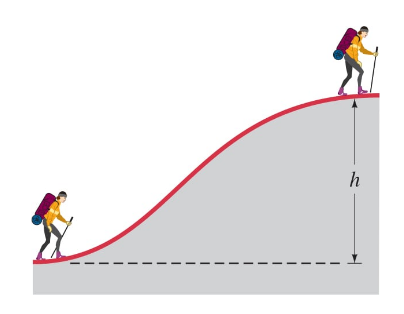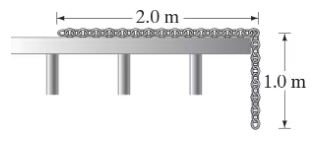 Back
BackProblem 3
A 55.0-kg firefighter climbs a flight of stairs 28.0 m high at constant speed. How much work does she do?
Problem 4
The head of a hammer with a mass of 1.2 kg is allowed to fall onto a nail from a height of 0.65 m. What is the maximum amount of work it could do on the nail? Why do people not just “let it fall” but add their own force to the hammer as it falls?
Problem 7.100d
A 2.0-kg block slides across a rough surface with a constant coefficient of kinetic friction of 0.50 (Fig. 7–38a). The block starts at x= 0 with an initial velocity of 4.9 m/s. Pushing the block is a force directed at 36.8° below the horizontal and whose magnitude increases with position as shown in Fig. 7–38b.
<IMAGE>
(d) Draw a line on the graph showing the magnitude of the friction force versus distance x.
Problem 9
Estimate the work you do to mow a lawn 10 m by 20 m with a 50-cm-wide mower. Assume you push with a horizontal force of about 15 N.
Problem 10
In a certain library the first shelf is 15.0 cm off the ground, and the remaining four shelves are each spaced 38.0 cm above the previous one. If the average book has a mass of 1.25 kg with a height of 22.0 cm, and an average shelf holds 28 books (standing vertically), how much work is required to fill all the shelves, assuming the books are all laying flat on the floor to start?
Problem 15
A grocery cart with mass of 16 kg is pushed at constant speed up a 12° ramp by a force FP which acts at an angle of 17° below the horizontal. Find the work done by each of the forces (m, , ) on the cart if the ramp is 7.5 m long.
Problem 38
If the hill in Example 7–2 (Fig. 7–4) was not an even slope but rather an irregular curve as in Fig. 7–23, show that the same result would be obtained as in Example 7–2: namely, that the work done by gravity depends only on the height of the hill and not on its shape or the path taken.
Problem 39
The net force exerted on a particle acts in the positive x direction. Its magnitude increases linearly from zero at x = 0, to 380 N at x = 3.0m. It remains constant at 380 N from x = 3.0m to x = 7.0m, and then decreases linearly to zero at x = 12.0m. Determine the work done to move the particle from x = 0 to x = 12.0m graphically, by determining the area under the Fₓ versus x graph.
Problem 45
Consider a force F₁ = which acts on an object during its journey along the x axis from x = 0.0 to x = 1.0m, where A = 3.0 Nm¹⸍². Show that during this journey, even though F₁ is infinite at x = 0.0, the work W done on the object by this force is finite, and determine W.
Problem 52
A 2800-kg space vehicle, initially at rest, falls vertically from a height of 2900 km above the Earth’s surface. Determine how much work is done by the force of gravity in bringing the vehicle to the Earth’s surface.
Problem 53
A 3.0-m-long steel chain is stretched out along the top level of a horizontal scaffold at a construction site, in such a way that 2.0 m of the chain remains on the top level and 1.0 m hangs vertically, Fig. 7–27. At this point, the force on the hanging segment is sufficient to pull the entire chain over the edge. Once the chain is moving, the kinetic friction is so small that it can be neglected. How much work is performed on the chain by the force of gravity as the chain falls from the point where 2.0 m remains on the scaffold to the point where the entire chain has left the scaffold? (Assume that the chain has a linear weight density of 24 N/m.)
Problem 54
At room temperature, an oxygen molecule, with mass of 5.31 x 10⁻²⁶ kg, typically has a kinetic energy of about 6.21 x 10⁻²¹ J . How fast is it moving?
Problem 64
A 3.5-kg object moving in two dimensions initially has a velocity = (10.0 î + 20.0 ĵ) m/s. A net force then acts on the object for 2.0 s, after which the object’s velocity is = (15.0 î + 30.0 ĵ) m/s. Determine the work done by on the object.
Problem 68
A car traveling at a velocity v can stop in a minimum distance d. What would be the car’s minimum stopping distance if it were traveling at a velocity of 2v?
Problem 77
The force required to compress an “imperfect” horizontal spring (doesn’t follow Hooke’s law) an amount x is given by F = 150x + 12x³, where x is in meters and F in newtons. If the spring is compressed 2.0 m, what speed will it give to a 3.0-kg ball held against it and then released?
Problem 83a
In the game of paintball, players use guns powered by pressurized gas to propel 33-g gel capsules filled with paint at the opposing team. Game rules dictate that a paintball cannot leave the barrel of a gun with a speed greater than 85 m/s. Model the shot by assuming the pressurized gas applies a constant force F to a 33-g capsule over the length of the 32-cm barrel. Determine F by using the work-energy principle.
Problem 85
We usually neglect the mass of a spring if it is small compared to the mass attached to it. But in some applications, the mass of the spring must be taken into account. Consider a spring of unstretched length ℓ and mass MS uniformly distributed along the length of the spring. A mass m is attached to the end of the spring. One end of the spring is fixed and the mass m is allowed to vibrate horizontally without friction (Fig. 7–31). Each point on the spring moves with a velocity proportional to the distance from that point to the fixed end. For example, if the mass on the end moves with speed v₀, the midpoint of the spring moves with speed v₀ / 2. Show that the kinetic energy of the mass plus spring when the mass m is moving with velocity v is K = (1/2)Mv² where M = m + (1/3)MS is the “effective mass” of the system. [Hint: Let D be the total length of the stretched spring. Then the velocity of an infinitesimal length dx of spring, of mass dM, located at x is v(x) = v₀(x/D). Note also that dM = dx( MS/D).]
Problem 86a
A 25-g projectile is fired into a cube of ballistic gel at a velocity of 360 m/s. If the projectile penetrates 15 cm into the gel before stopping, find the average force exerted by the gel onto the projectile. Use kinematics and dynamics (Newton's laws).
Problem 87a
An airplane pilot fell 370 m after jumping from an aircraft without his parachute opening. He landed in a snowbank, creating a crater 1.1 m deep, but survived with only minor injuries. Assuming the pilot’s mass was 82 kg and his terminal velocity was 45 m/s, estimate the work done by the snow in bringing him to rest.
Problem 89b
A package of mass m is placed onto a horizontal conveyor belt moving at speed v (Fig. 7–32). The coefficient of kinetic friction between package and belt is μₖ. What is the package's displacement d during this time?
Problem 94a
A simple pendulum consists of a small object of mass m (the “bob”) suspended by a cord of length ℓ (Fig. 7–34) of negligible mass. A force is applied in the horizontal direction (so = Fî ), moving the bob very slowly so the acceleration is essentially zero. (Note that the magnitude of will need to vary with the angle θ that the cord makes with the vertical at any moment.) Determine the work done by this force, , to move the pendulum from θ = 0 to θ₀.
<IMAGE>


